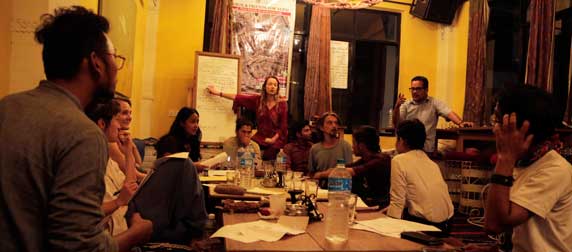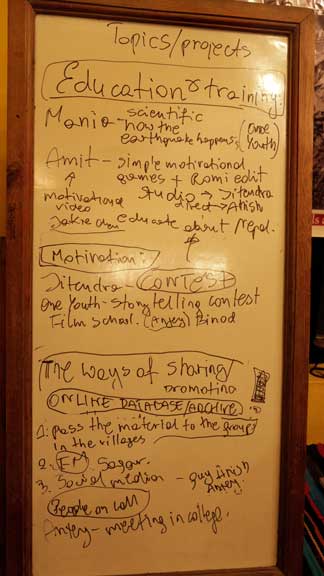Although I have been working behind the scenes with the Nepal Futures Makers team, attending meetings, advising, and working on strategy on how to engage people locally, I am now also spending quite a bit of time on creating a independent media center in Kathmandu.
Initially, I did some relief work, going out to villages in the Kathmandu valley, helping to clear out rubble and build temporary structures. I tried to start a few projects based on my previous work- one being one-minute video project for Nepal—giving everyone a chance to share ideas and listen to each other through short videos and another video mapping project based on the derive. But these have not yet gotten much traction, so I have been on the look out for other ways to engage with people in Kathmandu.
Luckily, last week when I was out on a building day, I met some people who were making a how-to-video for building temporary structures out of bamboo. We got to talking and decided it would be great to form a media team. We had a meeting the next day and about 25 people showed up. This group came mainly from relationships developed out of two local earthquake relief initiatives Kathmandu Earthquake Volunteers and Help Nepal.

At the first meeting we discussed many media needs for the burgeoning movement of self-organized collaborative efforts that have come out of the earthquake response. Some of the project ideas, training, information from needed from experts, examples of good practices that were floated at the time were:
- Explain how to identify PTSD- describe different ways that people respond to Trauma how to support them
- Psychological help for volunteers- how to take care of self—working hard and long in the crisis.
- Awareness videos on human trafficking.
- How to prepare for monsoon season and best practices in building temporary structures.
- Education – facts about the earthquake (about on how to talk with children or elderly about earthquake what happened).
- Reasons for moving back into the house (many old people continue to insist on sleeping outside).
- Education on Public Health : toilets, hygiene and sanitation.
- Establish a system for helping to revitalize the tourist economy.
- How to help grassroots organizations raise funds and funding videos.
- Develop entrepreneurial skills and employment.
- Sustainable development/ permaculture—how and why— land management—teach benefits of organic farming.
- Team work how to work as a group.
We also discussed how to best reach the people in remote villages with this information:
- Screenings in villages: mobile cinema -movie theatre in a backpack
- Short videos – that do not require much editing. 1 minute short video
- Graphic novels or zines—way to get across information that is accessible without internet
- Audio on the radio—local FM Radio Nepal-- BBC
- Slogans and posters—need graphic designer and content
- Photo essays with transcripts from training videos.
- Sharing stories and experiences- story telling.
- Articles for local newspapers/ press conference

- Disaster management- go to children they can teach their parents
- Use the international community- everyone has someone in their family that is abroad so can use that network— have more connection to internet and can share.
- Posters with information in front of meeting areas
- Use facebook other social media
At the end of this productive and ambitious meeting, in an off hand way, I mentioned how great it would be to have a space. One of the main organizers said “OK” To my surprise the next day I got a text from him letting me know that we had a space.
So we now have a media center and co-working space in the center of Kathmandu! There is a core group of about 8 of us who are here regularly but we have many people stopping by discussing their projects, getting media trainings or support for the work they are doing and just hanging out. Many of the project ideas discussed in the first meeting are now in production.
We have had many meetings big and small in the last week, and are working to set up a work flow, how to best connect projects to producers, magically finding equipment when needed, and struggling to keep track of all the ideas and contacts. The meetings are chaotic as so many people have great projects and many ideas. The atmosphere is optimistic and enthusiastic. There is a lot of talk about how media can help with rebuilding in a way that promotes sustainable development and collaborative engagement throughout Nepal. People who worked with self-initiated relief efforts now have a new sense of the possibilities for the country and understand the important role independent citizen-led media can have in the kind of political, economic and social transformation many are talking about.